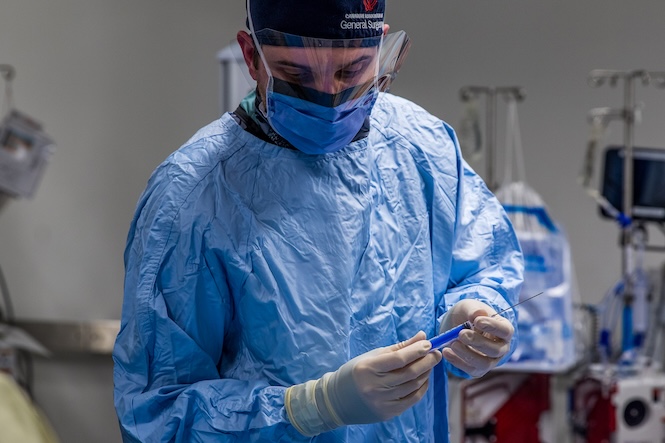Following the St. Michael’s trauma team on a typical shift.
A helicopter descends into Toronto’s downtown core minutes before 4:30 p.m., rotor blades whirring against a clear blue sky as it cuts a line between skyscrapers and lands on the roof of St. Michael’s Hospital.
The patient, injured in a car crash outside of the city, is rushed from the helipad into an elevator and down to the trauma bay, where physicians, nurses, respiratory therapists and imaging experts get to work.
It’s a typical evening in ‘trauma season’ at one of Canada’s top trauma care hospitals. That’s the name given to a stretch of warm summer months when injuries increase as people take to the outdoors on bicycles, boats, motorcycles and cars. Each year, roughly 1,500 patients from across Ontario are cared for by the elite trauma team at St. Michael’s, but in the warmer months between May and October, they see a surge: 855 people were cared for last year at that time. For the past three years, trauma teams were activated 434 times in August alone.
St. Michael’s, part of Unity Health Toronto health care network, is a key partner in delivering urgent care to Ontarians. It is one of only a handful of hospitals outside of the United States verified as a Level 1 Trauma Centre by the American College of Surgeons. That verification, awarded in 2023, means injured patients receive the highest quality care informed by the best available evidence from an elite trauma team with support from radiology, transfusion medicine, emergency medicine, surgery, research, rehabilitation, emergency preparedness, anesthesiology, intensive care and more.
In trauma, every minute counts, but none more so than the first 60 minutes following a traumatic event or injury.
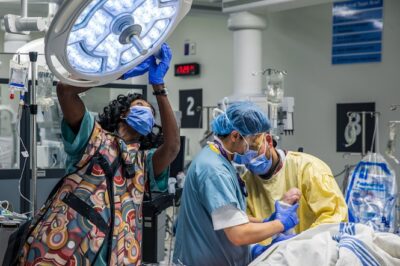
That’s why St. Michael’s has a helipad. Patients from across the province are air-lifted by Ornge helicopters to regional trauma centres like St. Michael’s to get access to specialties they wouldn’t have closer to home like neurosurgery and advanced imaging.
“There has to be a lot of collaboration between first responders and hospital teams,” says trauma surgeon Dr. Andrew Beckett, Director of Trauma at St. Michael’s. “For a patient to survive it has to be a finely tuned system.”
A former army medic and current lieutenant-colonel in the Canadian Armed Forces, Beckett served in Yugoslavia in the 1990s, and again in Iraq and Afghanistan in the early 2000s. In addition to his work as a surgeon, Beckett is a passionate researcher who has spent years investigating and advocating for better mechanisms for things like blood transfusion and pre-hospital care.
“No one is more important than anyone else,” he says of the team. “I am one cog in the machine.”
Saving lives through teamwork, research and expertise
Unlike most war hospitals, St. Michael’s is home to a vast network of surgical specialties. Neurosurgeons, orthopaedic surgeons and plastic surgeons often consult and operate on cases that come in, among many other possibilities. Having this kind of expertise right in the building gives patients a better chance at not only survival, but optimal recovery from their injuries.
Shortly after 5 p.m. Beckett enters the trauma bay and is greeted by trauma team leader Dr. Garrick Mok. The patient will need scans to evaluate potential head injuries, and then further monitoring to decide whether surgery is necessary.
As a trauma surgeon, Beckett’s expertise isn’t immediately needed. He’ll follow the patient for the next hour as Mok and the team decide on a treatment plan, and then he’ll wait for other cases that come in during the 15 hours he’s on call.
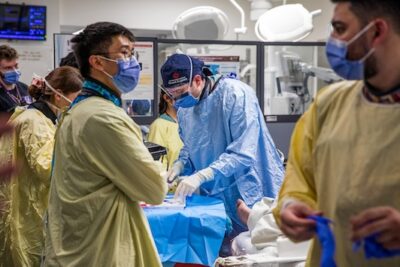
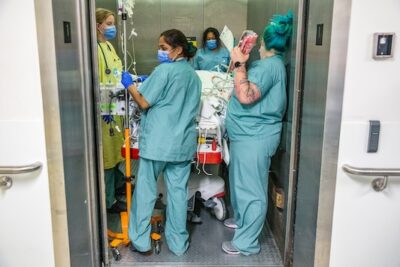
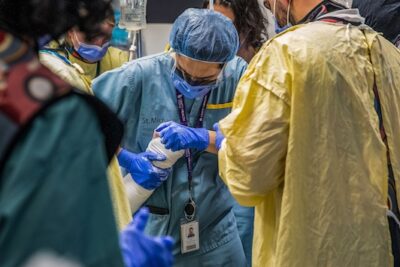
The team finishes up in the trauma bay and heads up to the imaging department. Beckett, Mok and a group of technologists and residents examine brain scans and converse on next steps.
As well as an acute care hospital in Toronto’s downtown core, St. Michael’s Hospital is a research hub and academic teaching hospital fully affiliated with the University of Toronto. More than 5,000 learners and trainees advance their medical and health care careers at one of Unity Health’s three hospital sites each year.
“There has to be a lot of collaboration between first responders and hospital teams,” says Beckett. “For a patient to survive it has to be a finely tuned system.”
During a few minutes of down time, a general surgery resident, Dr. Noemie Elfassy, approaches Beckett with a theoretical question.
“Proximal subclavian arterial injury. What would you do?” she asks, her scrub cap decorated by rainbows and unicorns.
Beckett responds in equally impressive medical syntax. Subclavian arteries, found beneath the collarbones, move blood from the heart to the rest of the upper body. In penetrating traumas these arteries can be injured.
After a few minutes of spontaneous teaching, Beckett, Mok and the residents turn to look at brain scans on the computer screens. They decide the patient doesn’t need surgery and can be moved to the intensive care unit.
Improving the ‘golden hour’ of trauma care
At St. Michael’s, trauma care doesn’t begin and end in the trauma bay or even in the operating room. Teams of researchers have dedicated their careers to examining how they can improve patient outcomes and the quality of care in the years to come.
Mok, who also serves as Deputy Chief of the Emergency Department, spearheaded a study that evaluates the quality of care CPR patients receive in the hospital when they are being resuscitated. Beckett, in partnership with the army, is researching the use of dried blood products to make transfusion easier and more accessible for civilians and soldiers.
Dr. Steve Lin, current Chief of the Emergency Department, is leading a national study that examines the optimal dose of epinephrine to give patients during cardiac arrest. The study partners closely with paramedic services to ensure patients are getting the best treatment as early as possible.
Dr. Brodie Nolan and Dr. Johannes von Vopelius-Feldt, emergency and trauma physicians and scientists, are looking into the feasibility of creating critical care response teams that would meet patients at the site of injuries. New studies led by Dr. Nolan and Dr. Michelle Sholzberg, clinical hematologist at St. Michael’s, even incorporate artificial intelligence to support the treatment of head injuries and massive bleeding.
Unity Health is also home to a Simulation Program that allows clinicians to train using manikins in hyper-realistic scenarios, so that when real patients come through the emergency department doors they are ready for anything. Unity Health’s Simulation Program hosts more than 5,000 interprofessional health profession learners, hospital administrators and support staff every year. Even the layout of the trauma bay has been specifically designed based on research to ensure the team can function as efficiently as possible.
What sets St. Michael’s apart is this dedication to figuring out how to improve those first 60 minutes of care. The critical “golden hour” of trauma care as clinicians often call it.
Transforming trauma care for Canadians
Beckett often stays at the hospital all night during his on call shifts, knowing from experience that anything can happen at any time.
Trauma can mean many things: violent injuries from gunshots and stabbings, closed head injuries from falls and car accidents, limb injuries and penetrating wounds. These patients are often brought to the hospital by ambulance or helicopter, and rather than being evaluated in the emergency department they are brought right to the specially equipped and designed trauma bays.
Trauma patients are often unconscious by the time they arrive at the hospital, and in many cases are sedated or intubated by the time they are brought to the operating room if
surgery is required.
Trauma surgeons, as Beckett puts it, are like quarterbacks deciding on how patients’ care will roll out. Is a head injury more pressing than broken bones? Should a scan happen before sutures? Is the patient stable enough to make it upstairs to the operating room?
“No one is more important than anyone else,” Beckett says of the team. “I am one cog in the machine.”
Beckett says it can be strange to operate on people and be present for some of the most challenging times in their lives without ever having properly met them.
“I usually don’t get to meet them or know them until they’ve recovered and come back for follow up
appointments,” he says.
Many patients are incredibly grateful when they do meet their surgeon, but as they physically recover, trauma patients are also grappling with the aftershocks of their experience.
The psychological toll of a traumatic experience can be massive, and Beckett has had to deliver hard news to families over the course of his career. Things like life-altering injuries, or – in the worst case scenario – news about a loved ones’ death. Social workers are present for trauma cases and help to answer family members’ and loved ones’ questions. A trauma clinic is also accessible upon referral for patients who don’t require admission to the hospital but need help through things like post-traumatic stress and concussion follow-up.
But on the other side of the coin are the many times he’s able to share good news. Patients who have – in no small part because of first responders, the trauma team and other specialties – pulled through harrowing ordeals and gone on to live full lives.
Without his experience as an army medic, Beckett likely wouldn’t have chosen trauma as a specialty.
War zones and downtown hospitals both have their unique challenges, but Beckett’s research and work have consistently proven that what happens on a battlefield can also apply to treating civilian populations.
If dried blood can help a soldier on the front lines, it could also be useful for a car crash patient who needs a transfusion right at the scene of the trauma. These are the kinds of ideas and innovations that will transform trauma care for Canadians.
With their patient in the capable hands of the St. Michael’s ICU team, Mok finishes up his long shift and gets ready to leave the hospital and Beckett returns to his office at around 7:30 p.m. to wait for other cases.
By Olivia Lavery


